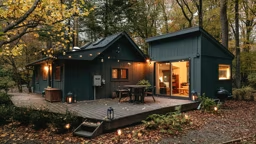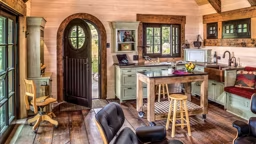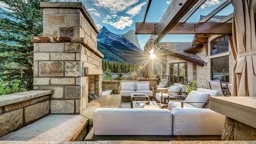TIPS FOR
BUYING, INSTALLING & MAINTAINING
SKYLIGHTS
Consider the warranty. A good quality skylight will come with at least a 20-year warranty on the glass and 10 years on the frame. Avoid limited warranties.
First, how’s the roof? Don’t install a skylight in a worn or damaged roof. If you’re planning on replacing the roof in a year or two, that’s an ideal time to add a skylight.
Ease of installation. Is an electrician required for wiring motorized skylights, or is the skylight pre-wired so you can simply plug it into an existing outlet?
Choose your installer carefully. Installation is the most critical aspect. To perform at its best, a skylight must be installed properly. Choose an installer who has a good reputation and will back their work. If you are installing the skylight yourself, be sure you have the proper flashing kit (see above).
Where? If you have a choice on which side of your home to place a skylight, consider the north side of the roof, since it provides ample ambient natural light with less direct sunlight and potential heat buildup.
Cleaning. Use 10 percent vinegar mixed with 90 percent water and a clean, lint-free cotton cloth to clean the glass of your skylight inside and out.
Keep the bugs out. Insect screens are a must for a venting skylight. Some companies include insect screens as a standard feature of their venting skylight units.
BUYING, INSTALLING & MAINTAINING
SKYLIGHTS
Consider the warranty. A good quality skylight will come with at least a 20-year warranty on the glass and 10 years on the frame. Avoid limited warranties.
First, how’s the roof? Don’t install a skylight in a worn or damaged roof. If you’re planning on replacing the roof in a year or two, that’s an ideal time to add a skylight.
Ease of installation. Is an electrician required for wiring motorized skylights, or is the skylight pre-wired so you can simply plug it into an existing outlet?
Choose your installer carefully. Installation is the most critical aspect. To perform at its best, a skylight must be installed properly. Choose an installer who has a good reputation and will back their work. If you are installing the skylight yourself, be sure you have the proper flashing kit (see above).
Where? If you have a choice on which side of your home to place a skylight, consider the north side of the roof, since it provides ample ambient natural light with less direct sunlight and potential heat buildup.
Cleaning. Use 10 percent vinegar mixed with 90 percent water and a clean, lint-free cotton cloth to clean the glass of your skylight inside and out.
Keep the bugs out. Insect screens are a must for a venting skylight. Some companies include insect screens as a standard feature of their venting skylight units.
Skylights do for a home what sunroofs do for cars. They bring wide, open spaces into what would otherwise be a closed and contained area. Open a skylight and you open your home to the breezes and sounds and scents of the great outdoors.
Here are some tips on what to look for and how to maintain a properly functioning skylight
for years of enjoyment.
• Ample glass area. A skylight with plenty of glass will provide added natural light and a better view, while maintaining privacy.
• Adequate ventilation (more than a crack). Venting provides plenty of fresh air and temperature control. In the summer, when used in combination with open windows, venting skylights help release the hot air that gets trapped near the ceiling, while open windows can bring in cooler air from outside.
• A good fit . Gaps, air leaks or moisture condensation are not standard fare with standard skylights. Expect today’s skylight to perform just as you would any other window in the home – even in snowy climates.
• Easy open and close. Most skylights are available with powered operation options that open and close the skylights with the touch of a button (with battery back-ups in the event of a power failure), and a rain sensor that automatically closes the skylight when it detects precipitation.
• Shades. The ability to control the amount of light can be important, especially for east-facing skylights in bedrooms. (Not everyone wants to rise with the sun.) Room-side shades are available for venting units (which open) or skylights that are fixed in place (non-opening).
• Good glass. Avoid a single-glazed skylight. Instead, look for skylights with sealed insulating Low-E (low emissivity) glass to protect from heat and sun, which helps keep your home cooler in the summer and warmer in the winter, and protects interior décor items from harmful ultraviolet (UV) rays which can fade furnishings.
• A natural blend into the home’s interior. A natural wood-framed interior skylight offers choices on painting or staining to match the existing décor.
• The right flashing kit. Flashing protects your home between the roofing material and skylight, providing a barrier at the seam. Most skylight companies will offer different flashing kits to best fit different types of roofing applications.
Kathy Harkema works for the Pella Corporation, where she knows the ins and outs of skylights.
Here are some tips on what to look for and how to maintain a properly functioning skylight
for years of enjoyment.
• Ample glass area. A skylight with plenty of glass will provide added natural light and a better view, while maintaining privacy.
• Adequate ventilation (more than a crack). Venting provides plenty of fresh air and temperature control. In the summer, when used in combination with open windows, venting skylights help release the hot air that gets trapped near the ceiling, while open windows can bring in cooler air from outside.
• A good fit . Gaps, air leaks or moisture condensation are not standard fare with standard skylights. Expect today’s skylight to perform just as you would any other window in the home – even in snowy climates.
• Easy open and close. Most skylights are available with powered operation options that open and close the skylights with the touch of a button (with battery back-ups in the event of a power failure), and a rain sensor that automatically closes the skylight when it detects precipitation.
• Shades. The ability to control the amount of light can be important, especially for east-facing skylights in bedrooms. (Not everyone wants to rise with the sun.) Room-side shades are available for venting units (which open) or skylights that are fixed in place (non-opening).
• Good glass. Avoid a single-glazed skylight. Instead, look for skylights with sealed insulating Low-E (low emissivity) glass to protect from heat and sun, which helps keep your home cooler in the summer and warmer in the winter, and protects interior décor items from harmful ultraviolet (UV) rays which can fade furnishings.
• A natural blend into the home’s interior. A natural wood-framed interior skylight offers choices on painting or staining to match the existing décor.
• The right flashing kit. Flashing protects your home between the roofing material and skylight, providing a barrier at the seam. Most skylight companies will offer different flashing kits to best fit different types of roofing applications.
Kathy Harkema works for the Pella Corporation, where she knows the ins and outs of skylights.
 Pella Corporation, www.pella.com
Pella Corporation, www.pella.com  Pella Corporation, www.pella.com
Pella Corporation, www.pella.com 









